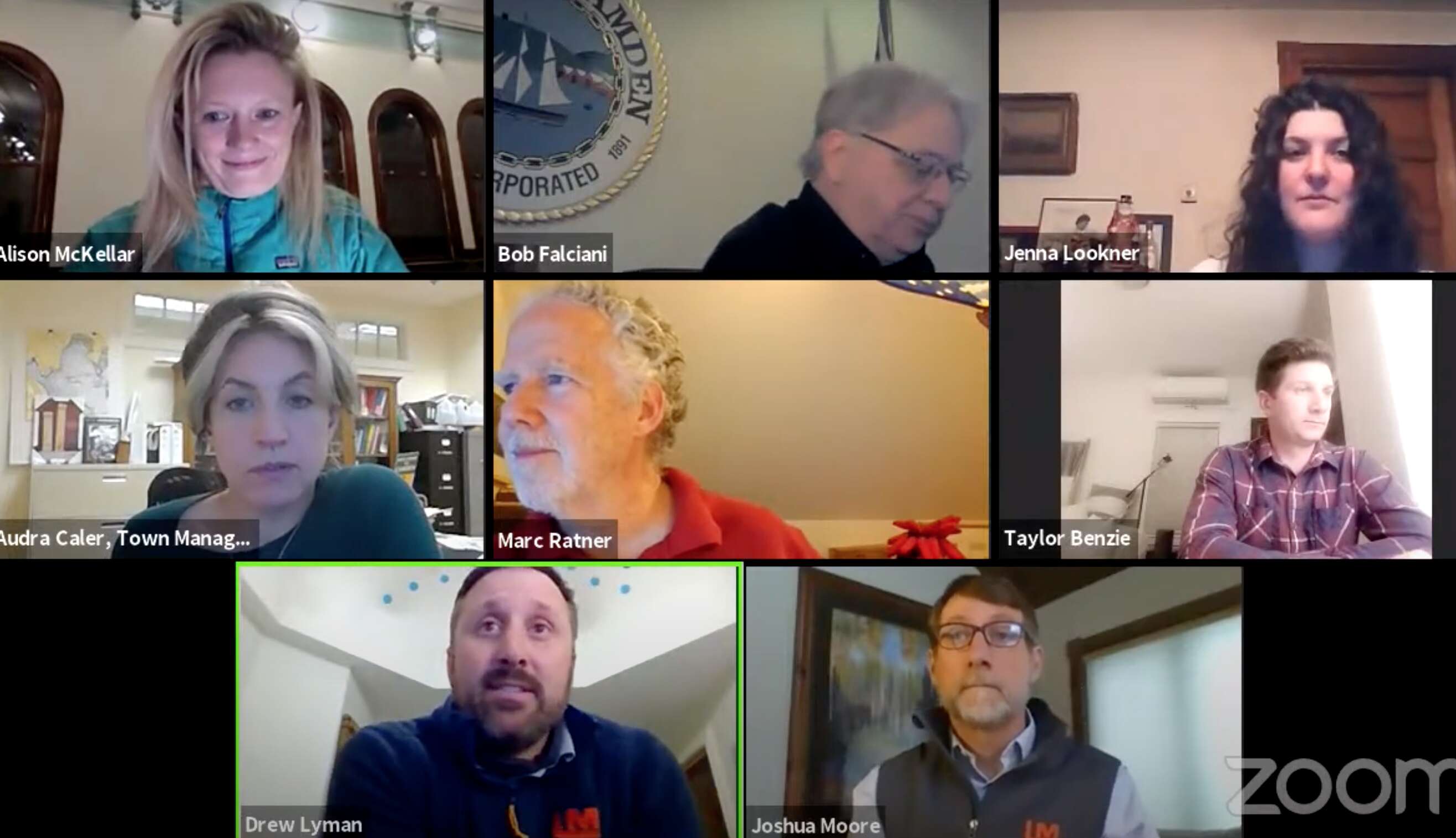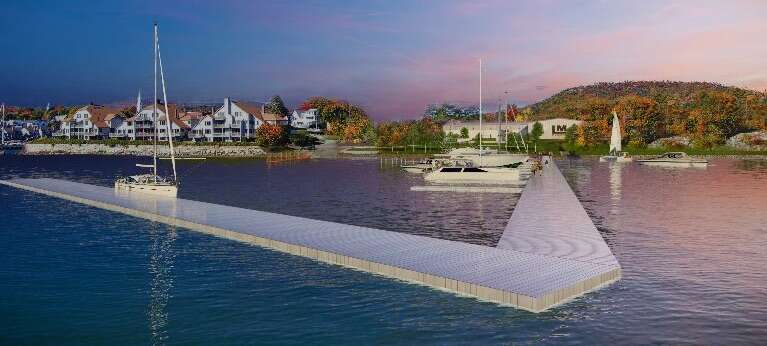
Processing Your Payment
Please do not leave this page until complete. This can take a few moments.
Camden considers public-private partnership to upgrade harbor infrastructure
 Courtesy / Lyman-Morse Boatbuilding
A rendering shows the proposed extension of Camden’s Harborwalk.
Courtesy / Lyman-Morse Boatbuilding
A rendering shows the proposed extension of Camden’s Harborwalk.
Lyman-Morse Boatbuilding is pitching the town of Camden on a public-private partnership to upgrade the harbor infrastructure there.
Goals include growing the transient-boater market, improving public amenities such as the town Harborwalk, and growing the local economy through increased visitor spending.
Lyman-Morse, headquartered in Thomaston, owns a marina and boatyard on Camden’s waterfront.
At a recent virtual meeting, the town Select Board indicated it was receptive to the ideas presented.
“I can see the potential for this being beneficial for the town,” said Select Board member Taylor Benzie. “It would be crazy for us not to explore this opportunity.”
$30M investment
The proposal would have a price tag of over $30 million in investment by Lyman-Morse and by the town in “necessary improvements” to municipal and private waterfront facilities, Joshua Moore, the company’s special projects director, told the board.
An estimated $10 million in town spending is needed for upgrades to aging town infrastructure, including a public landing and a landing ramp, outer harbor breakwaters, parking and connectivity for the Harborwalk.
Lyman-Morse plans to invest about $20 million for improvements to its boatyard, including redevelopment of a building for marine services.

“Competition from nearby harbors, damaged or outdated structures and market pressures require private investment in waterfront facilities,” the proposal says.
According to the proposal, opportunities exist for a public-private collaboration on two of the projects: improvements and connectivity to a municipal boat landing called Steamboat Landing and an extension of the Harborwalk.
Lyman-Morse is proposing to build and operate a new pier and dock system at Steamboat Landing, and to build the Harborwalk extension. The town would retain ownership of both.
Steamboat Landing is adjacent to Lyman-Morse’s Camden facility.
Proposed improvements to Steamboat Landing’s pier and dock include a new fixed pier, a wave-attenuating floating dock to protect Steamboat Landing’s ramp, and additional floating and finger docks. The proposed extension of Harborwalk includes an elevated shoreside public walkway along ht outer harbor, seating for harbor views, and a boardwalk and ADA-compliant pedestrian pathway through Lyman-Morse’s inner harbor boatyard.
$1.5M grant
The proposal includes leveraging a $1.5 million federal grant that Lyman-Morse received in 2019.
At that time, the company, partnering with the Maine Department of Transportation, was awarded $1.5 million through the U.S. Fish and Wildlife Service’s Boating Infrastructure Grant program, to construct and install a 120-foot fixed pier, 334-foot wave-attenuating floating dock, 579-foot floating dock, and 16 slips for other transient vessels, providing 2,000 linear feet of new dockage for transient boaters.
The proposal is designed to serve a growing yacht market, with the global fleet having doubled since 1997, said Moore. In addition, he said, large-scale marina investments are being made in the neighboring harbors of Belfast, Rockland and Portland, partly driven by a growing transient boating circuit.
“Infrastructure improvements will keep Camden as a premier destination on the boating circuit without undue pressure on existing harbor facilities,” the proposal says.
Boater spending
Transient boat visitors provide economic benefits to the town, including spending on fuel, restaurants and bars, grocers and lodging, according to the proposal.

But the harbor’s capacity to grow the transient fleet is currently limited. Existing transient dockage is at full capacity 75% of the season and today’s sailboats need deeper water than the 10-foot depths provided by the inner harbor, the proposal says.
“In terms of whether or not we need to build all of this, the answers is a resounding yes,” said Moore. “The yacht market is growing.”
Additional benefits of the plan, said Moore, are expected to include expanded working waterfront through additional dock and marine service staff, improved public access to the harbor via the new walkway and pier, more local spending by attracting new visitors without increasing vehicle traffic, and relieving boat congestion in Camden’s inner harbor.
Moore said the plan also represents environmental benefits, providing new protections to waterfront infrastructure as storms become more frequent and violent.
The proposal envisions revising an existing tax increment financing district to provide an incentive for other private property owners on the harbor to improve their facilities for the public good.
The presentation to the council was the first step before pursuing a slew of permits for the plan at the local, state and federal levels, Moore said. That work includes coordinating with town staff and committees on details, site plan reviews and ordinance revisions, plus a town meeting vote on ordinance amendments; with the Maine departments of economic and community development and environmental protection and the state’s submerged lands program; and with U.S. Fish & Wildlife on administration of the $1.5 million grant and U.S. Army Corps of Engineers for permits.
The timeline for constructing the project is still several years out, said Moore. But the company must submit a plan by this September to U.S. Fish & Wildlife on how the $1.5 million will be used, he added.
More congestion?
Select board member Alison McKellar expressed concern that more transient boaters would mean more congestion in the harbor.
“Different people in Camden feel differently about recruiting large vessels to town,” said McKellar. “How do you decide how many boats is too many for Camden?”
Small boats, like kayaks and paddleboarders, already have a difficult time navigating among powerboats, she said.
“Are there ways we can increase the number of boats that can come and enjoy Camden without making it even less safe for smaller boats?” she said.
Lyman-Morse’s president, Drew Lyman, said the vision is to increase boating and other waterfront activities at all levels, including adding children’s sailing programs. The goal, he said, is to “create an energy and a vibe” that supports a variety of uses and bring more people to the area.
“A lot of these details we’ll flesh out with you going forward,” Lyman said.
“We’re asking the town to take the next step to get this plan in front of voters this summer,” said Moore.
Town staffers said there’s not enough time to get the plan before voters in time for the regular town meeting in June. They said a special town meeting would have to be scheduled later in the summer.
“I support it,” said select board member Marc Ratner. “I think we’re looking toward the future. It helps our year-round economy, it helps jobs, it supports a lot of our town stores and restaurants and bed-and-breakfasts.”
Due to a fire last June, Lyman-Morse has begun a major upgrade of its inner harbor boatyard, including new marine service facilities and shoreside amenities, according to the company’s website.
Mainebiz web partners
Leadership looking forward. Waterfront access in a working and recreational harbour is good for the community













1 Comments